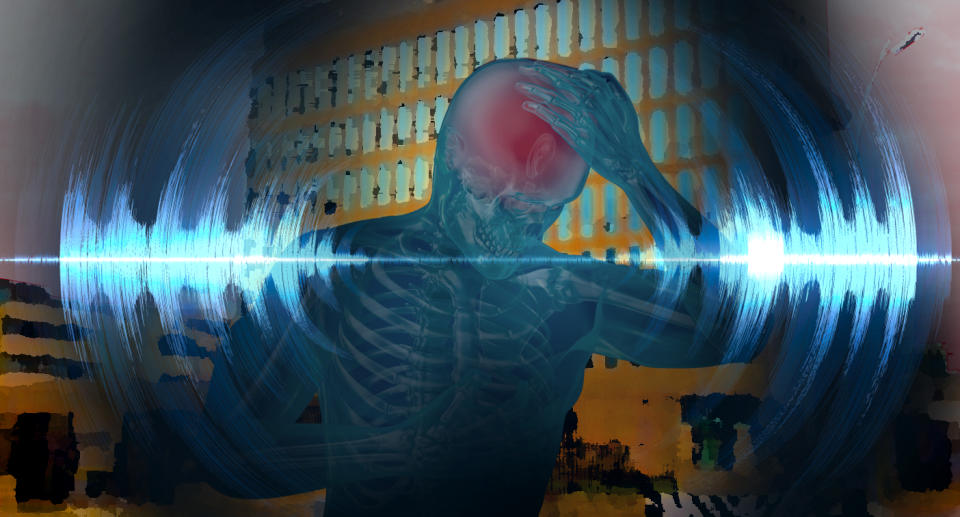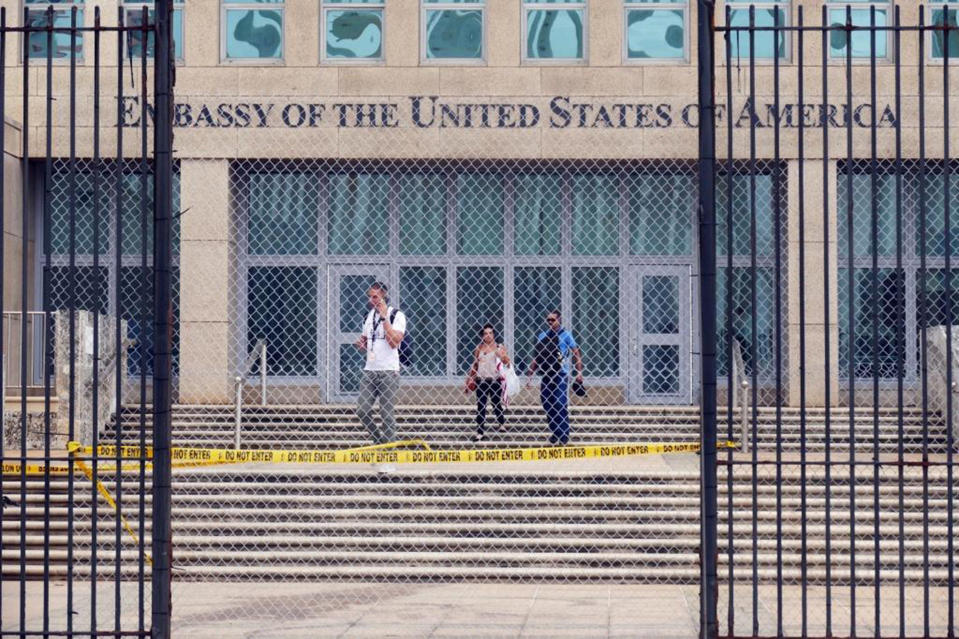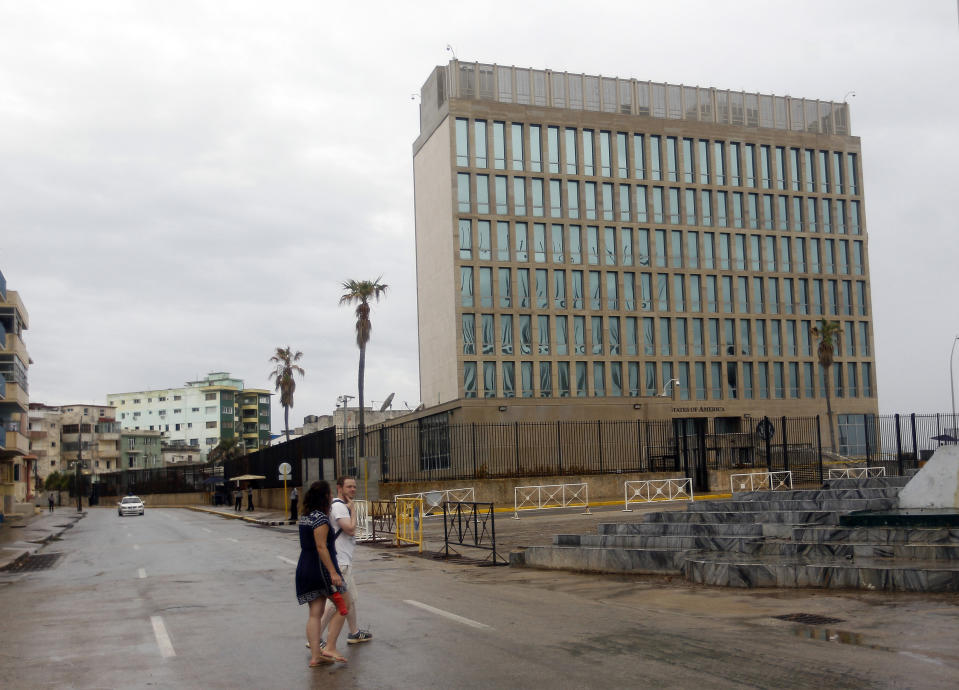Scientists say ‘neuroweapons’ were behind Cuba attacks

WASHINGTON — Could a foreign country build a directed-energy weapon tailored to target a single diplomat walking through a house, leaving other occupants unaffected? What about drugs that target a person’s brain, or even a specific part of the brain? Yes, it’s possible, according to scientists who have been studying the possible causes of the mysterious health effects reported among U.S. diplomatic personnel in Havana, Cuba.
Four scientists, including the first doctor to examine the diplomats reporting symptoms in Cuba, took part in a Pentagon-sponsored teleconference on Friday, where they announced new research results, including what they determined to be the probable use of “neuroweapons” in what they called the Havana Effect.
At issue are the more than two dozen U.S. government officials stationed in Havana, who have described hearing strange sounds, followed by a combination of medical symptoms, including dizziness, hearing loss and cognitive problems. More recently, a similar case has been reported in a U.S. embassy worker in Guangzhou, China. For months, a mix of secrecy and speculation has surrounded those incidents, including an increasingly popular theory that the diplomats were the victims of microwave weapons.
Michael Hoffer, an otolaryngologist at the University of Miami, who was the first to conduct tests on the embassy workers, said on the Friday call that the diplomats are suffering from a “neurosensory dysfunction,” which is primarily affecting their sense of balance.
The Friday call was organized as part of a study program sponsored by the Pentagon and titled “Probable Use of a Neuroweapon to Affect Personnel of US Embassy in Havana: Findings, Pathology, Possible Causes, and Disruptive Effects.”
A Pentagon official told Yahoo News that the briefing was offered by the scientific team for interested people in the Defense Department and was to gain “general knowledge” about their findings. “This didn’t have an operational element,” the official said.
During the call, Hoffer gave a broad description of his findings, and promised that published results would be out soon. “I’m going tell you that this data is all going to be coming out in more detail in a peer-reviewed publication,” Hoffer said. “That peer-reviewed publication is due out probably in the next three to four weeks.” Hoffer did not say where the results would be published.

But Hoffer’s results could result in deepening the controversy around the Cuba incidents, since he concludes that the symptoms do not match those of brain injury — as posited by another group of scientists — and instead could be limited to the ear canal. “It’s important to know that that site of injury could be limited to the inner ear,” he said, noting that the diplomats affected appear to have damage to parts of the inner ear, known as the otolith organs, which affect balance.
Injury to those organs can cause dizziness, among other symptoms.
Earlier this year, scientists at University of Pennsylvania, who saw the patients after Hoffer did, determined that affected personnel were suffering from something akin to a mild traumatic brain injury, according to an article they published in the Journal of American Medical Association.
Hoffer did not discuss those published results during the call, and did not respond to a request for comment, but he said on Friday that “the definition of mild traumatic brain injury as defined by the military does not fit these individuals.” The authors of the JAMA study did not respond to a request for comment.
Little has been previously known about Hoffer’s involvement in evaluating U.S. diplomats stationed in Cuba, and the Friday call appears to be his most extensive public comment to date on precisely how and why he became involved.
“I got a call from the State Department in February of 2017, and literally, the call was, ‘This is the State Department, we have a problem.’” he said. “They spoke to me about individuals who began experiencing symptoms late in 2016 with ear pain, ringing in the ear, dizziness and cognitive issues.”
Hoffer said he and his team evaluated 35 personnel in Miami: 25 of those have been exposed to the sounds and were symptomatic, and 10 lived in the same house at the same time as those reporting symptoms but did not appear to be affected. “So they were in the next room and they didn’t get an exposure, they didn’t have any symptoms,” he said.
He then traveled to Cuba, where his team evaluated 105 unaffected embassy personnel. “Those were largely selected for us by the embassy mission, except for a group of U.S. Marines that protect the embassy,” he said. “We requested to see them ourselves, due to my 21 years of active-duty service.”
One important aspect of Hoffer’s research is that he evaluated the affected individuals before there was any media coverage of the event, which could have triggered others into believing they were affected. “This is the only group of individuals who were, in a sense, pure,” he said.

Hoffer said he has not examined any U.S. diplomats from China, and indicated he wasn’t allowed to speak about other patients he might have seen. “As regards to foreign countries, I can tell you this much: Great Britain, Germany, Canada and France described it potentially being present in their embassy individuals,” he said. “But we either can’t say, or are not allowed to say if we saw any of those individuals.”
Hoffer’s involvement in examining affected personnel is not without controversy, however. A 2011 article in Time magazine titled, “Dr. Frankenstein — or Military Miracle Worker?” detailed allegations that Hoffer had treated U.S. soldiers in Iraq affected by traumatic brain injury with an untested drug, and that he had a financial interest in the treatment. A Department of Defense Inspector General report harshly criticized the study, calling it “inconsistent with military standards for human subject medical research.”
In a congressional hearing Friday to discuss the Cuba health incidents, Rep. Eliot Engel, D-N.Y., the ranking member of the House Committee on Foreign Affairs, questioned a senior State Department official about the decision to send the affected diplomats to Hoffer, given his previous research.
“Doesn’t it seem a bit strange that our diplomats suffering from ‘concussion-like’ symptoms would be sent to a doctor who apparently did not use standard concussion assessments?” Engel asked Charles Rosenfarb, the State Department’s medical director. “Isn’t that strange?”
“At the time, we felt he was the best qualified person — the recommendations we received to do the initial evaluation,” Rosenfarb replied.
Rosenfarb said that State Department later determined that the injury “was probably not localized to the acoustic system, that it was more kind of a broader brain injury process” and sent the patients to specialists at the University of Pennsylvania.
This is not the first time Congress has expressed concern about the State Department’s handling of the mysterious health issue. Engel, along with committee’s chairman, Rep. Ed Royce, R-Calif., wrote to the State Department late last year asking why the Centers for Disease Control and Prevention had not initially been involved in reviewing the health incidents.
“I think it’s a no-brainer that as our nation’s top experts on health threats, the CDC, should be at the forefront of this investigation with the appropriate experts deployed in Havana,” Engel said Friday.
The State Department made a formal request to the CDC in December of 2017, according to Rosenfarb, and the agency is now involved. “We have been very happy with CDC to this point,” he said.
But a congressional aide, who asked not to be named, said that CDC’s involvement is still limited. The agency’s personnel went to China as soon as a case was reported there, but they haven’t been to Cuba.
“These are our nation’s top experts,” the aide said. “These are the people who should be looking at it.”
The CDC did not respond to questions about the agency’s involvement. A State Department spokesperson declined to comment on the CDC’s involvement.
Hoffer’s involvement is only one aspect of a complex investigation that has given rise to multiple theories, including the possibility that the health issues were caused by exotic weaponry or even just mass hysteria.
While Hoffer’s work is focused primarily on understanding the type of injury causing the symptoms, both he and his colleague on the call Friday seemed to agree that some sort of neuroweapon was used. Their theories for the type of device employed ranged from a directed-energy weapon, such as one using microwaves, to a weaponized microbe or drug designed to cause injury, or a combination of both.

“Is it possible and probable that drugs alone could do this?” asked James Giordano, a professor of neurology and biochemistry at Georgetown University during the call. “Highly unlikely. Is it possible and probable that ultrasonics can do this? Yes, it’s very possible, and it’s probable. Is it possible and probable that electromagnetic pulse devices that would then be propagated either directly or vectored could do this? Yes, it’s very, very possible and very probable.”
Giordano suggested that an attacker could even model a weapon based on the specific dimension of a person’s head. “Could something like this be developed that actually models specific features that could then be precision or personalized? The answer to that question would be yes,” Giordano said. “If you had anthropometric dimensions on a certain individual, that could be extracted, for example, from pictures.”
Carey Balaban, a professor of otolaryngology at the University of Pittsburgh School of Medicine, who worked with Hoffer, says there are commercial off-the-shelf — known as COTS — devices that could be used in such attacks. “When you take a look at the availability of COTS devices, insect-repellent type devices, and the footprint, there could be something that looks like your thermostat inside the house that is one component of a ultrasound and [radio frequency] type of delivery system, and it could just be there,” he said, speaking on the Friday call. “We don’t know.”
While Balaban said it was unclear what type of device was used, the health effects seemed to indicate it was, in fact, a directed-energy weapon, which could result in cavitation — essentially air bubbles — in the inner ear. “If anything else, the Havana Event is a wakeup call for us, we really have to take a look at these kinds of gray area neuroweapons very carefully,” he said.
Yet much of the information that has come out appears to defy any singular technological explanation.
One theory, for example, is the noise diplomats heard was caused by pulsed microwaves, which can create the perception of audible sound, a phenomenon known as the Frey effect, or the “microwave auditory” effect. That theory, however, would be contradicted by the recordings released earlier this year by the Associated Press, since the microwave auditory effect isn’t caused by sound waves.
Writing Friday in Scientific American, Kenneth Foster, who has published on the microwave auditory effect, called this “theory wildly implausible,” because of the energy levels that would have been required. “To actually damage the brain, the microwaves would have to be so intense they would actually burn the subject, which has never happened in any of these incidents,” wrote Foster, a professor of bioengineering at University of Pennsylvania.
Foster instead speculated that a surveillance device could have inadvertently caused the injuries to U.S. personnel, a theory proposed earlier this year by University of Michigan computer scientists. Their theory, which received widespread press attention, is that overlapping ultrasonic devices intended to spy on diplomats inadvertently emitted sounds at a dangerous frequency.
“There’s something funny going on,” Jonathan Moreno, a bioethicist at the University of Pennsylvania, who is not involved in any of the medical research into the affected personnel, said in an interview. “Whether the event itself is real or not, the reaction is real.”
While there’s not enough known to make any conclusions, “I still think the Michigan engineers’ theory seems the most plausible,” says Moreno.
Yet even something less exotic — like a surveillance operation gone wrong — has difficulty making sense of all the facts. Why would an accidental injury caused by surveillance devices leave family members in the same household unscathed? How could a perpetrator target individuals as they moved around from room to room, as has been reported? And an interesting twist to many of the theories is a new detail given by Hoffer: When diplomats opened the front door, the sound they heard went away.
Another critical question — particularly one raised by Cuban government officials, who have vigorously denied any involvement — is why would anyone want to injure diplomats? One theory is that someone orchestrated the attack to fracture relations between the United States and Cuba.

Speaking on the same call Friday, Diane DiEuliis, a senior research fellow at the National Defense University, described these neuroweapons as something that would be “very highly effective” in “gray zones,” where an enemy would use them to have plausible deniability. “Certainly, using these kinds of technologies as a weapon of mass destruction is possible,” she said. “I think what we would be more likely to see as the use of this as a weapon of mass disruption.”
The microwave weapons claims have echoes in the past. In the 1960s, the U.S. government ran a top-secret program to test whether microwaves being beamed at the U.S. embassy in Moscow were intended as mind-control weapons. After several years of research, government scientists concluded the Moscow Signal, as it was called, was being used to activate listening devices in the embassy, rather than controlling diplomats’ minds.
The mystery now, however, is in some ways deeper. The research into the Moscow Signal was sparked by the detection of microwaves, whereas this time, the health effects are what sparked the investigation. And though a number of agencies and outside experts have been consulted on the Cuba health issues, it’s unclear how those efforts are being coordinated, or by whom.
Justin Sanchez, the director of the biological technologies office at the Pentagon’s Defense Advanced Research Projects Agency, confirmed that his division was among those asked to look at the Cuba issue. “We understand the brain. We have expertise in this area,” he said in an interview. “If somebody didn’t ask us, I’d be surprised.”
Sanchez declined to say what DARPA’s experts advised. “I don’t know if there’s a definitive answer yet to what’s going on,” he said, when asked what could be the cause.
“Somebody needs to get the bottom of it,” he said.
_____
Read more from Yahoo News:
Omarosa says she’s ready to testify at Trump’s impeachment trial
House Intel Dem: Trump collusion with Russia ‘is well established’
Unborkable: Kavanaugh heads into confirmation hearings on cruise control
Former presidents pay homage as McCain takes his place in history
Cory Booker is on the campaign trail, but not in the way you might think



